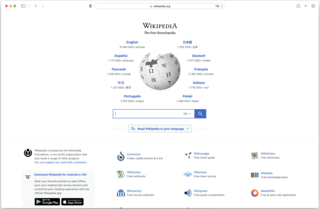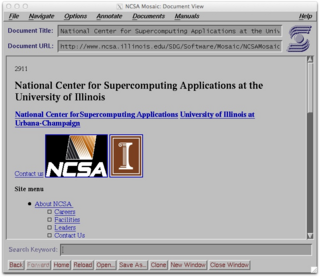Related Research Articles

Lynx is a customizable text-based web browser for use on cursor-addressable character cell terminals. As of 2024, it is the oldest web browser still being maintained, having started in 1992.
Netscape Navigator is a discontinued proprietary web browser, and the original browser of the Netscape line, from versions 1 to 4.08, and 9.x. It was the flagship product of the Netscape Communications Corporation and was the dominant web browser in terms of usage share in the 1990s, but by around 2003 its user base had all but disappeared. This was partly because the Netscape Corporation did not sustain Netscape Navigator's technical innovation in the late 1990s.
Netscape Communications Corporation was an American independent computer services company with headquarters in Mountain View, California, and then Dulles, Virginia. Its Netscape web browser was once dominant but lost to Internet Explorer and other competitors in the first browser war, with its market share falling from more than 90 percent in the mid-1990s to less than one percent in 2006. An early Netscape employee, Brendan Eich, created the JavaScript programming language, the most widely used language for client-side scripting of web pages. A founding engineer of Netscape, Lou Montulli, created HTTP cookies. The company also developed SSL which was used for securing online communications before its successor TLS took over.

The World Wide Web is an information system that enables content sharing over the Internet through user-friendly ways meant to appeal to users beyond IT specialists and hobbyists. It allows documents and other web resources to be accessed over the Internet according to specific rules of the Hypertext Transfer Protocol (HTTP).

A web browser is an application for accessing websites. When a user requests a web page from a particular website, the browser retrieves its files from a web server and then displays the page on the user's screen. Browsers are used on a range of devices, including desktops, laptops, tablets, and smartphones. By 2020, an estimated 4.9 billion people had used a browser. The most-used browser is Google Chrome, with a 67% global market share on all devices, followed by Safari with 18%.

NCSA Mosaic was among the first widely available web browsers, instrumental in popularizing the World Wide Web and the general Internet by integrating multimedia such as text and graphics. Mosaic was the first browser to display images inline with text.

Ramanathan V. Guha is the creator of widely used web standards such as RSS, RDF and Schema.org. He is also responsible for products such as Google Custom Search. He was a co-founder of Epinions and Alpiri. He worked at Google for nearly two decades, most recently as a Google Fellow, before announcing his departure from the company in August 2024.

Marc Lowell Andreessen is an American business person and former software engineer. He is the co-author of Mosaic, the first widely used web browser with a graphical user interface; co-founder of Netscape; and co-founder and general partner of Silicon Valley venture capital firm Andreessen Horowitz. He co-founded and later sold the software company Opsware to Hewlett-Packard; he also co-founded Ning, a company that provides a platform for social networking websites. He is an inductee in the World Wide Web Hall of Fame. Andreessen's net worth is estimated at $1.7 billion.
This is a comparison of both historical and current web browsers based on developer, engine, platform(s), releases, license, and cost.

SlipKnot was one of the earliest World Wide Web browsers, available to Microsoft Windows users between November 1994 and January 1998. It was created by Peter Brooks of MicroMind, Inc. to provide a fully graphical view of the web for users without a SLIP or other TCP/IP connection to the net, hence the name – SLIP...not. SlipKnot provided a graphical web experience through what would otherwise be a text-only Unix shell account. SlipKnot version 1.0 was released on November 22, 1994, approximately 3 weeks before Netscape's Netscape Navigator version 1.0 came out. It was designed to serve a significant fraction of PC/Windows-based Internet users who could not use Mosaic or Netscape at that time.
The blink element is a non-standard HTML element that indicates to a user agent that the page author intends the content of the element to blink. The element was introduced in Netscape Navigator but is no longer supported and often ignored by modern Web browsers; some, such as Internet Explorer, never supported the element at all.
In computing, the same-origin policy (SOP) is a concept in the web-app application security model. Under the policy, a web browser permits scripts contained in a first web page to access data in a second web page, but only if both web pages have the same origin. An origin is defined as a combination of URI scheme, host name, and port number. This policy prevents a malicious script on one page from obtaining access to sensitive data on another web page through that page's (DOM).

Microsoft Internet Explorer 2 (IE2) is the second, and by now discontinued, version of Internet Explorer (IE), a graphical web browser by Microsoft. It was unveiled in October 1995, and was released on November 27, 1995, for Microsoft Windows, and on April 23, 1996, for Apple Macintosh.

The World Wide Web is a global information medium that users can access via computers connected to the Internet. The term is often mistakenly used as a synonym for the Internet, but the Web is a service that operates over the Internet, just as email and Usenet do. The history of the Internet and the history of hypertext date back significantly further than that of the World Wide Web.
Comet is a web application model in which a long-held HTTPS request allows a web server to push data to a browser, without the browser explicitly requesting it. Comet is an umbrella term, encompassing multiple techniques for achieving this interaction. All these methods rely on features included by default in browsers, such as JavaScript, rather than on non-default plugins. The Comet approach differs from the original model of the web, in which a browser requests a complete web page at a time.

HTTP cookies are small blocks of data created by a web server while a user is browsing a website and placed on the user's computer or other device by the user's web browser. Cookies are placed on the device used to access a website, and more than one cookie may be placed on a user's device during a session.
Jon E. Mittelhauser is a software executive who co-wrote the Windows version of NCSA Mosaic and was a founder of Netscape.
A web browser is a software application for retrieving, presenting and traversing information resources on the World Wide Web. It further provides for the capture or input of information which may be returned to the presenting system, then stored or processed as necessary. The method of accessing a particular page or content is achieved by entering its address, known as a Uniform Resource Identifier or URI. This may be a web page, image, video, or other piece of content. Hyperlinks present in resources enable users easily to navigate their browsers to related resources. A web browser can also be defined as an application software or program designed to enable users to access, retrieve and view documents and other resources on the Internet.
The University of Kansas School of Engineering, founded in 1891 is the oldest Engineering School in the State of Kansas, although engineering degrees were awarded as early as 1873. It is an ABET accredited, public engineering school located on the main campus of the University of Kansas in Lawrence, Kansas.
Download: The True Story of the Internet is a documentary television series about Internet history. It is aired on Science Channel in the US and Discovery Channel for other countries. It originally aired on March 3, 2008. The show was hosted by John Heilemann.
References
- ↑ Grobe, Michael. (April 10, 1997) An Early History of Lynx: Multidimensional Collaboration. Retrieved Jan. 8, 2023.
- ↑ Robert Cailliau (May 1994). "WWW94 Awards". CERN. Retrieved 2011-09-25.
- ↑ "The World-Wide Web Hall of Fame". Best of the Web Directory. 1994. Retrieved 2011-09-25.
- ↑ "2002 Young Innovators Under 35". Technology Review. 2002. Retrieved August 16, 2011.
- ↑ Steven Johnson (2022). "The Magic Cookie: How Lou Montulli Cured the Web's Amnesia". Netguru . Retrieved August 17, 2022.
- ↑ Lou Montulli. "A Short History of the Fishcam" . Retrieved 2009-02-20.
- ↑ Eric Perlman. "Wacky Uselessness". Archived from the original on 2010-11-25. Retrieved 2009-02-20.